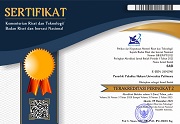Population Growth: Challenges In The Fulfillment of The Right To Work
 ), Ampuan Situmeang(2), Febri Jaya(3)
), Ampuan Situmeang(2), Febri Jaya(3)
(1) Faculty of Law International Batam University, Batam, Indonesia
(2) Faculty of Law International Batam University, Batam, Indonesia
(3) Faculty of Law International Batam University, Batam, Indonesia
 Corresponding Author
Corresponding Author
Abstract
Introduction: Population growth has positive and negative impacts on a region. Batam city is a city with a fairly large population and Batam City must be able to fulfill its citizens' rights.
Purposes of the Research: This study aims to analyze the fulfillment of the right to work and identify ways to control the rate of population growth to meet the need for jobs.
Methods of the Research: The method used in this research is normative juridical. The study used is library research. The basis used in this study is the juridical basis which consists of the 1945 Constitution, Law Number 39 of 1999 concerning Human Rights and the theoretical basis used is the legal system theory of Lawrence Meir Friedman.
Results of the Research: Based on the results of the study, it was found that the population growth in the Batam city is increasing and the Batam city has an obligation to fulfill the right to work for its residents. Therefore, Batam City must make a population grand design which also contains strategic plans for managing human resources and strategies for preparing jobs for its residents
Keywords
DOI
10.47268/sasi.v29i3.1316
Published
2023-06-12
How To Cite
@article{SASI1316,
author = {Winsherly Tan and Ampuan Situmeang and Febri Jaya},
title = {Population Growth: Challenges In The Fulfillment of The Right To Work},
journal = {SASI},
volume = {29},
number = {3},
year = {2023},
keywords = {Population; Fulfillment; Right to Work.},
abstract = {Introduction: Population growth has positive and negative impacts on a region. Batam city is a city with a fairly large population and Batam City must be able to fulfill its citizens' rights.Purposes of the Research: This study aims to analyze the fulfillment of the right to work and identify ways to control the rate of population growth to meet the need for jobs. Methods of the Research: The method used in this research is normative juridical. The study used is library research. The basis used in this study is the juridical basis which consists of the 1945 Constitution, Law Number 39 of 1999 concerning Human Rights and the theoretical basis used is the legal system theory of Lawrence Meir Friedman. Results of the Research: Based on the results of the study, it was found that the population growth in the Batam city is increasing and the Batam city has an obligation to fulfill the right to work for its residents. Therefore, Batam City must make a population grand design which also contains strategic plans for managing human resources and strategies for preparing jobs for its residents},
issn = {2614-2961}, pages = {427--441} doi = {10.47268/sasi.v29i3.1316},
url = {https://fhukum.unpatti.ac.id/jurnal/sasi/article/view/1316}
}
Journal Article
Banjaransari, Ayu Putri Rainah Petung. “Legal Protection for Indonesia Ship Crew Working on Foreign Ship.” Journal of Judicial Review 24, no. 2 (2022): 261–72.
Ekwarso, Hendro, and Lapeti Sari. “Pelayanan Administrasi Kependudukan Sebagai Bentuk Pelayanan Pemerintahan Yang Berkualitas Di Provinsi Kepulauan Riau.” Jurnal Sosial Ekonomi Pembangunan 3, no. 8 (2013): 189–205.
Fariz Wajdi, and Imran. “Pelanggaran HAM Dan Tanggung Jawab Negara Terhadap Korban.” Jurnal Yudisial 14, no. 2 (2021): 229–46. https://doi.org/10.29123/jy.v14i2.445.
Franita, Riska, and Andes Fuady. “Analisa Pengangguran Di Indonesia.” Jurnal Ilmu Pengetahuan Sosial 6, no. 1 (2019): 88–93.
Jatmiko, Bayu Dwiwiddy. “Menelisik Pengakuan Dan Perlindungan Hak-Hak Asasi Politik Pasca Perubahan UUD 1945.” Jurnal Panorama Hukum 3, no. 2 (2019): 217–46.
Khairunnisa, Andi Akhirah. “Penerapan Prinsip-Prinsip Hak Asasi Manusia Dalam Pembentukan Produk Hukum Oleh Pemerintah Daerah.” Jurnal Manajemen Pemerintahan 5, no. 1 (2018): 65–78. https://ejournal-new.ipdn.ac.id/JMP/article/view/451.
Kurniawan, Fajar, and Wisnu Aryo Dewanto. “Problematika Pembentukan RUU Cipta Kerja Dengan Konsep Omnibus Law Pada Klaster Ketenagakerjaan Pasal 89 Angka 45 Tentang Pemberian Pesangon Kepada Pekerja Yang Di PHK.” Jurnal Panorama Hukum 5, no. 1 (2020): 63–76.
Marini, Lisa, and Novi Tri Putri. “Peluang Terjadinya Pengangguran Di Provinsi Bengkulu: Seberapa Besar?” Convergence: The Journal of Economic Development 1, no. 1 (2019): 70–83. https://doi.org/10.33369/convergence-jep.v1i2.10900.
Muhammad, Mukmin. “Hak Asasi Manusia Dalam Hukum Positif Dengan Konsep Constitutional Importance.” Meraja 1, no. 2 (2018): 31–38.
Priastiwi, Dian, and Herniwati Retno Handayani. “Analisis Pengaruh Jumlah Penduduk, Pendidikan, Upah Minimum Dan PDRB Terhadap Tingkat Pengangguran Terbuka Di Provinsi Jawa Tengah.” Diponegoro Journal of Economics 1, no. 1 (2019): 159.
Rasu, Andreas, Noortje Marsellanie Benu, and Elsje Pauline Manginsela. “Dampak Industri PT. Global Coconut Terhadap Masyarakat Di Desa Radey, Kecamatan Tenga, Kabupaten Minahasa Selatan.” Jurnal Agri-Sosio Ekononomi Unsrat 13, no. 1 (2017): 99–112.
Riyanda, Riko, and Atanasius Dula. “Peran Dinas Tenaga Kerja Kota Batam Terhadap Perencanaan Pembangunan Ketenagakerjaan Dalam Meningkatkan Kompetensi Tenaga Kerja Pada Era Masyarakat Ekonomi Asean (MEA).” MENARA Ilmu 14, no. 2 (2020): 83–93. http://www.kemendag.go.id/pusdiklat/news.
Saefuloh, Asep Ahmad. “Kebijakan Ketenagakerjaan Pada Sektor Industri Di Kota Batam.” Kajian 16, no. 1 (2011): 189–217. https://jurnal.dpr.go.id/index.php/kajian/article/view/522.
Supriyanto, Bambang Heri. “Penegakan Hukum Mengenai Hak Asasi Manusia (HAM) Menurut Hukum Positif Di Indonesia.” Al-Azhar Indonesia Seri Pranata Sosial 2, no. 3 (2014): 151–68.
Tantimin, and Elizabeth Sinakuban. “Perlindungan Hukum Terhadap Hak Tenaga Kerja Perempuan Terkait Ketidaksetaraan Gender Di Indonesia.” Nusantara: Jurnal Ilmu Pengetahuan Sosial 8, no. 3 (2021): 395–406.
Triwahyuningsih, Susani. “Perlindungan Dan Penegakan Hak Asasi Manusia (HAM) Di Indonesia.” Legal Standing : Jurnal Ilmu Hukum 2, no. 2 (2018): 113. https://doi.org/10.24269/ls.v2i2.1242.
Wahyudi, Slamet Tri. “Problematika Penerapan Pidana Mati Dalam Konteks Penegakan Hukum Di Indonesia.” Jurnal Hukum Dan Peradilan 1, no. 2 (2012): 207. https://doi.org/10.25216/jhp.1.2.2012.207-234.
Wartoyo, Franciscus Xaverius. “Peran Negara Menghadapi Problematika Hak Asasi Manusia (HAM) Dalam Lingkungan Hayati.” WASKITA: Jurnal Pendidikan Nilai Dan Pembangunan Karakter 4, no. 1 (2020): 57–66. https://doi.org/10.21776/ub.waskita.2020.004.01.5.
Wilujeng, Sri Rahayu. “Hak Asasi Manusia: Tinjauan Dari Aspek Historis Dan Yuridis.” Humanika 18, no. 2 (2013). http://journal.um-surabaya.ac.id/index.php/JKM/article/view/2203.
Yulia, Desma. “Sejarah Perkembangan Suku Laut Di Tanjung Gundap Kelurahan Tembesi Kecamatan Sagulung Batam Tahun 1982-2012.” Jurnal HISTORIA 1, no. 2 (2016): 139–52.
Zulfa, Eva Achjani. “Menelaah Arti Hak Untuk Hidup Sebagai Hak Asasi Manusia.” Lex Jurnalica 3, no. 11–23 (2005): 17975. https://ejurnal.esaunggul.ac.id/index.php/Lex/article/view/230.
Thesis, Web Page, and Others
Batam, BP. “Industri Di Batam Dan Berkenalan Dengan Jenis-Jenisnya,” 2021. https://bpbatam.go.id/industri-di-batam-dan-berkenalan-dengan-jenis-jenisnya/.
MC Kota Batam. “Ada 54.018 Pengangguran Di Kota Batam,” 2019. https://infopublik.id/kategori/nusantara/358323/ada-54-018-pengangguran-di-kota-batam.
| Dublin Core | PKP Metadata Items | Metadata for this Document | |
| 1. | Title | Title of document | Population Growth: Challenges In The Fulfillment of The Right To Work |
| 2. | Creator | Author's name, affiliation, country | Winsherly Tan; Faculty of Law International Batam University, Batam; Indonesia |
| 2. | Creator | Author's name, affiliation, country | Ampuan Situmeang; Faculty of Law International Batam University, Batam; Indonesia |
| 2. | Creator | Author's name, affiliation, country | Febri Jaya; Faculty of Law International Batam University, Batam; Indonesia |
| 3. | Subject | Discipline(s) | |
| 3. | Subject | Keyword(s) | Population; Fulfillment; Right to Work. |
| 4. | Description | Abstract | Introduction: Population growth has positive and negative impacts on a region. Batam city is a city with a fairly large population and Batam City must be able to fulfill its citizens' rights.Purposes of the Research: This study aims to analyze the fulfillment of the right to work and identify ways to control the rate of population growth to meet the need for jobs. Methods of the Research: The method used in this research is normative juridical. The study used is library research. The basis used in this study is the juridical basis which consists of the 1945 Constitution, Law Number 39 of 1999 concerning Human Rights and the theoretical basis used is the legal system theory of Lawrence Meir Friedman. Results of the Research: Based on the results of the study, it was found that the population growth in the Batam city is increasing and the Batam city has an obligation to fulfill the right to work for its residents. Therefore, Batam City must make a population grand design which also contains strategic plans for managing human resources and strategies for preparing jobs for its residents |
| 5. | Publisher | Organizing agency, location | Faculty of Law, Universitas Pattimura |
| 6. | Contributor | Sponsor(s) | Faculty of Law International Batam University, Batam |
| 7. | Date | (YYYY-MM-DD) | 2023-06-12 |
| 8. | Type | Status & genre | Peer-reviewed Article |
| 8. | Type | Type | |
| 9. | Format | File format | |
| 10. | Identifier | Uniform Resource Identifier | https://fhukum.unpatti.ac.id/jurnal/sasi/article/view/1316 |
| 10. | Identifier | Digital Object Identifier | 10.47268/sasi.v29i3.1316 |
| 11. | Source | Title; vol., no. (year) | SASI; Volume 29 Issue 3, September 2023 |
| 12. | Language | English=en | en |
| 13. | Relation | Supp. Files | |
| 14. | Coverage | Geo-spatial location, chronological period, research sample (gender, age, etc.) | |
| 15. | Rights | Copyright and permissions | Copyright: Authors who publish their manuscripts in this Journal agree to the following conditions: 1. The copyright in each article belongs to the author, as well as the right to patent. 2. Authors can enter into separate, additional contractual arrangements for the non-exclusive distribution of the journal's published version of the work (e.g., post it to an institutional repository or publish it in a book), with an acknowledgment of its initial publication in this journal. 3. Authors are permitted and encouraged to post their work online (e.g., in institutional repositories or on their website) before and during the submission process, as it can lead to productive exchanges, as well as earlier and greater citation of published work. 4. Authors have the right to self-archiving of the article (Author Self-Archiving Policy)
License: The SASI Journal is disseminated based on the Creative Commons Attribution-NonCommercial 4.0 International license terms. This license allows anyone to copy and redistribute this material in any form or format, compose, modify, and make derivatives of this material for any purpose. You cannot use this material for commercial purposes. You must specify an appropriate name, include a link to the license, and certify that any changes have been made. You can do this in a way that is appropriate but does not imply that the licensor supports you or your use.
|
Copyright (c) 2023 Winsherly Tan, Ampuan Situmeang, Febri Jaya

This work is licensed under a Creative Commons Attribution-NonCommercial 4.0 International License.

 : 2140 times
: 2140 times Download : 932 times
Download : 932 times
















